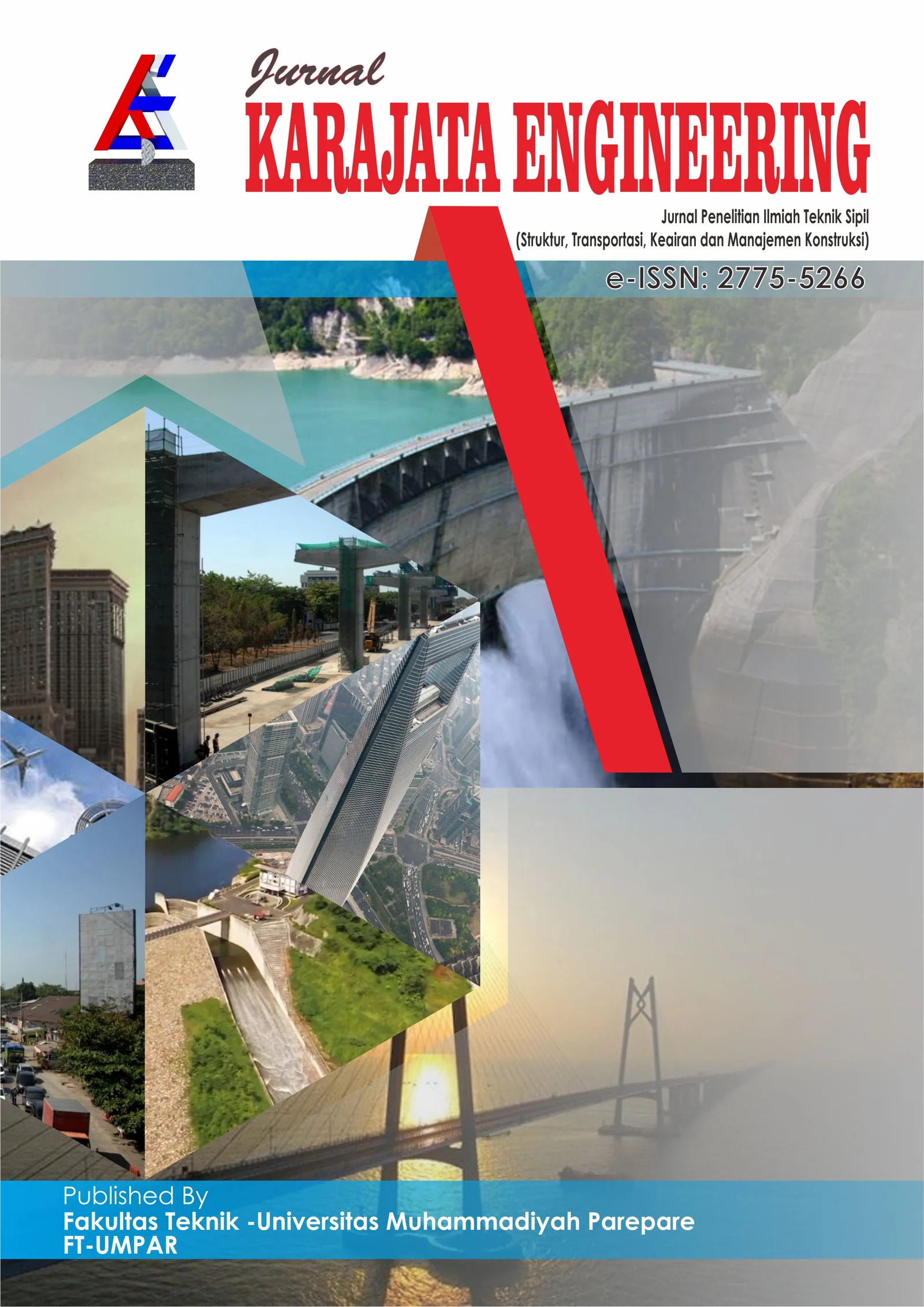Kajian Level Kinerja Struktur Apartemen 25 Lantai terhadap Beban Gempa dengan Analisis Pushover pada Sumbu Kuat
Abstract
High-rise projects like 25-storey apartment buildings often face construction challenges due to dense reinforcement, particularly in shear walls. Spatial constraints may prevent full rebar installation, as seen in a studied project in Jakarta, leading to minor reinforcement reductions. Although seemingly insignificant, such reductions can affect ductility and seismic performance. The site lies in Seismic Design Category D per SNI 1726:2019, requiring special seismic detailing and ensuring structures meet at least Damage Control (DC) performance under Maximum Considered Earthquake (MCE) conditions (2% probability in 50 years). The building uses a dual system—moment-resisting frames and shear walls—with a ductility factor of R=7R = 7R=7, following ATC-40 guidelines. Pushover analysis showed a maximum base shear of 3063.76 kN at 1298.59 mm roof displacement (step 18), while the performance point was reached at 619.45 mm displacement and 2250.89 kN base shear. Plastic hinges formed first in beams at step 7 and progressed until step 18. The building satisfies the DC performance level, indicating it can endure MCE-level earthquakes with low life-safety risk. Estimated repair costs at this level are around 35% of the structural value, confirming acceptable structural performance and safety for occupancy during major seismic events.
References
Ahmed, S. Y., Salih, O. A., & Najeebabba, O. (2022). Effect of plastic hinge properties in pushover analysis of reinforced concrete plane frames. International Research Journal of Innovations in Engineering and Technology.
American Society of Civil Engineers. (2017, December). Seismic evaluation and retrofit of existing buildings. American Society of Civil Engineers.
Arissaputra, S., & Irwan, J. (2025). Studi Kasus Perilaku Daktilitas Struktur Bangunan 20 Lantai Terhadap Defisiensi Mutu Beton Menggunakan Metode Pushover. Technologic, 16(1).
ASCE. (2000). Prestandard and commentary for the seismic rehabilitation of buildings. Rep. Prepared for FEMA, FEMA 356.
ATC-40. (1996). Seismic Evaluation and Retrofit of Concrete Buildings. SEISMIC SAFETY COMMISSION State of California.
Dusicka, P., & Kay, T. (2009). Seismic evaluation of a green building structural system: ICF grid walls. In Structures Congress 2009: Don't Mess with Structural Engineers: Expanding Our Role (pp. 1-7).
Ghobarah, A. (2001). Performance-based design in earthquake engineering: state of development. Engineering structures, 23(8), 878-884.
Kadid, A., & Boumrkik, A. (2008). Pushover analysis of reinforced concrete frame structures.
Luna, B. N., Rivera, J. P., & Whittaker, A. S. (2015). Seismic Behavior of Low-Aspect-Ratio Reinforced Concrete Shear Walls. ACI Structural Journal, 112(5).
Nasional, B. S. (2012). Tata cara perencanaan ketahanan gempa untuk struktur bangunan gedung dan non gedung. Sni, 1726, 2012.
Sutarno, S. (2023). Efektivitas pengekangan terhadap perilaku beton mutu tinggi berserat baja (Doctoral dissertation, Universitas Islam Sultan Agung (Indonesia)).
Tavio, U. W. (2018). Desain Rekayasa Gempa Berbasis Kinerja (Performance Based Design). Yogyakarta: Andi.
Utomo, C., Susanto, R. I., Tudjono, S., & Wibowo, H. (2012). Evaluasi Struktur dengan Pushover Analysis pada Gedung Kalibata Residences Jakarta (The Evaluation Of The Structure by Using Pushover Analysis of Kalibata Residences Building Jakarta). Jurnal Karya Teknik Sipil, 1(1), 1-10.
Vijayakumar, A., & Babu, D. V. (2012). Pushover analysis of existing reinforced concrete framed structures. European Journal of Scientific Research, 71(2), 195-202.
Zuher, M. H. (2023). Analisis Kurva Fragilitas Pada Struktur Bangunan 12 Lantai dengan Metode Pushover (Doctoral dissertation, Universitas Andalas).




.png)


.png)








